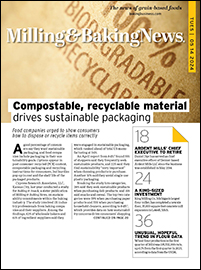KANSAS CITY — "Hyper-crunch” appears poised to emerge as a go-to texture term, according to London-based Tate & Lyle PLC’s Future of Mouthfeel report.
Hyper-crunch involves crunch, snap and sound, and the increased use of air fryers has heightened expectations for crunchy food, which is seen more often in savory foods in combinations like pickles in cheese blankets or air-fried pasta, the report said.
Whole Foods Market, Austin, Texas, also listed crunchy texture as one of its top 10 trends for 2025. Consumers are seeking crispy grains and granola, fermented nuts, roasted chickpeas and mushroom chips to add texture to breakfast, lunch and dinner, according to the specialty grocery retailer.
“Creating a ‘hyper-crunch’ often involves strategic combinations of ingredients,” said Marina Migueli, global marketing director of texturants and proteins for Tate & Lyle. “Tate & Lyle offers solutions like Artesa chickpea flour, which enhances the crunchy texture in snacks and crackers by optimizing dough structure. Additionally, our Xpand’R and Artesa lines excel in driving a hyper-crunchy texture by enabling air expansion within both traditional and gluten-free baked goods.”
Tate & Lyle’s Promitor soluble fiber also may be used in a granola bar’s binding syrup to help hold the particulates together and create a crunch in sweet baked foods, said Adrienne Pohrte, senior technical manager. She added hyper-crunch is appearing in both sweet and savory categories, including crispy kunafa-filled chocolate from Dubai, United Arab Emirates, or traditional snacks with bold spicy flavors.
 Tate & Lyle's Artesa chickpea flour enhances the crunchy texture in snacks and crackers by optimizing dough structure.
Tate & Lyle's Artesa chickpea flour enhances the crunchy texture in snacks and crackers by optimizing dough structure. Source: ©AGPHOTOGRAPHY - STOCK.ADOBE.COM
Hyper-crunch typically is coupled with bold flavors like mature cheeses, chili, cinnamon and caramel, said Venitia Sequeira, strategy manager for Tate & Lyle. Chocolate, caramel and cinnamon provide a sweet flavor, she said, while salty and umami flavors may come from mature cheeses, sour cream and savory pairings like dips. Nutty flavors are popular in Japan and Indonesia for their earthy appeal.
A crunchy texture may come from clusters and inclusions, too. CII, Leavenworth, Kan., offers clusters and inclusions for applications such as cereal, trail mixes, ice cream and baked foods, said Chris Foster, Midwest regional sales manager.
“In baked goods, our Flav-R-Bite line of products is great to add a colored and/or flavored crunch as a topping or inside the products like a low-sodium salt crunch on top of pretzel bread products or a dark chocolate cookie or caramel crunch inside the products,” he said. “We can also offer toasted oats for toppings on bread loaves, bagels and bars.”
Clusters and Nutri-Crisps line of products may be customized for each individual application to boost protein and fiber contents, and CII’s Flav-R-Bites line may be used to produce no-sugar-added bites.
“We also have a panning line where we can create coated fruit pieces that incorporate probiotics,” Foster said. “All of our product lines can be customized for any allergen restrictions that a project might have, and we can also manufacture organic and non-GMO items as well.”
CII operates seven extrusion lines in its Leavenworth facility. In its St. Joseph, Mo., facility, the company has a cluster/granola line, a panning line and a heat-treatment processing line.
Softness in bars
In some applications, softness and shelf life are preferred.
“As with many protein sources, such as whey and soy, some pea proteins can contribute to chalky, gritty or dry textures that harden over time,” said Rob Skorge, project leader for technical service at Ingredion, Inc., Westchester, Ill. “It is crucial to choose the right pea protein to ensure a smooth and creamy texture over shelf life for consumer acceptance. Additionally, some pea protein can have earthy, beany and bitter flavors that may not be desirable. Formulators often need to use flavor-masking agents or sweeteners to mitigate these off-notes, which can lengthen ingredient lists.”
Ingredion offers Vitessence Pea 100 HD, a pea protein optimized for cold-pressed bars. The ingredient maintains the softness of cold-pressed bars throughout shelf life, provides texture and sensory attributes, and adds nutritional value, according to the company.
“In accelerated shelf-life studies, Vitessence Pea 100 HD showed predictably low and stable softness over time compared to whey, soy and other pea proteins,” Skorge said. “This specialized pea protein uses a proprietary process to ensure a consistently functional product with fewer texture changes and desired sensory attributes for cold-pressed bars.”
By incorporating texture modifiers, such as certain fibers or emulsifiers, formulators can further enhance mouthfeel and reduce grittiness further, he said. Additionally, using non-hydrolyzed pea proteins can minimize bitter tastes and provide a cleaner label while maintaining a smooth texture. Ingredion sampled a plant-based chocolate tahini jelly protein bar that contained 8 grams of protein last July at IFT FIRST, the Institute of Food Technologists’ annual meeting and food exposition in Chicago.
“Pea protein isolates contain more than 80% protein on a dry basis, making it possible to achieve a good or excellent source of protein,” Skorge said. “Additionally, pea protein is free at the source from major allergens like dairy, soy and gluten, making it suitable for a wide range of consumers. It also has a lower environmental impact compared to animal-based proteins, contributing to a more sustainable food system.”
Multi-dimensional mouthfeel
Multi-dimensional mouthfeel, such as crunchy and airy, works in layered snack bars with crispy, creamy and chewy elements as well as in soft-steamed buns with crispy fillings, crackers with creamy toppings or cakes with multi-textural layers such as creamy fillings and crunchy inclusions, Tate & Lyle’s Pohrte said. Chocolate-flavored cookies have a visibly crumbly appearance, which suggests texture before a consumer takes a bite, according to Tate & Lyle. When the crunchy shell is bitten, it breaks with a soft sound. The moist interior has a creamy and slightly chewy filling.
Migueli said starches manage moisture migration in baked foods to ensure a crisp exterior and soft interior.
“For fillings, we use pectins to create stable, creamy textures,” she said. “This technology is essential in products like cookies, where balance between a crunchy exterior and chewy center is key. Combining these textures — crispy, soft, chewy, creamy or crunchy — helps create baked goods and snacks that are truly memorable.”






